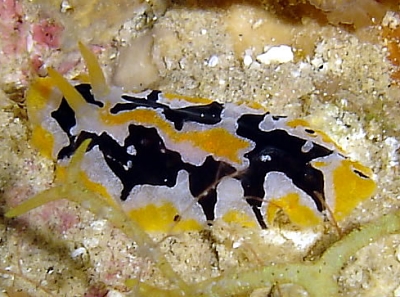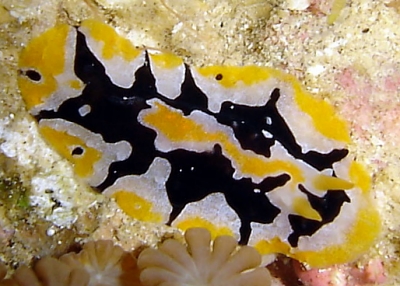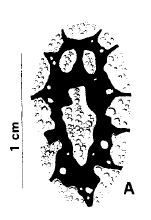Rediscovery of Phyllidiopsis monacha from the Red Sea
March 26, 2007
From: Binyamin Koretz


Dear Bill,
Sorry if this starts another Red Sea phyllidiid controversy, but we're pretty sure that this is Phyllidiopsis monacha (Yonow, 1986) [Phyllidia] which Brunckhorst (1993) synonymized it with P. dautzenbergi but it is obviously not P. dautzenbergi.
Locality: Eilat, Lighthouse Beach, 42m, Israel, Red Sea (Gulf of Eilat), 3 May 2006, coral reef. Length: 2cm. Photographer: Binyamin and Shulamit Koretz.
The problem obviously is that Yonow described the species from a single preserved specimen and there was no record of the colors of a living animal. The preserved animal was black and white except for "pale creamy orange pigmentation" retained at the gills. I have included a copy of Yonow's illustration (Fig 3A) [lower right ] to show that the pattern of black coloration in Yonow's holotype is sufficiently different from the pattern of typical P. dautzenbergi as to give one pause. In fact it matches our animal quite well, as you can see.
Best regards
Binyamin
binyamin@koretz.net
Koretz, B., 2007 (Mar 26) Rediscovery of Phyllidiopsis monacha from the Red Sea. [Message in] Sea Slug Forum. Australian Museum, Sydney. Available from http://www.seaslugforum.net/find/19682
Dear Binyamin,
As much as it would be nice to hide photos like this away, sometimes we just can't avoid controversies. This is a classic example of why it is best not to describe species from single, preserved, decolourised animals without any accompanying notes on the living animals or a photograph. I can see why Brunckhorst considered it to be a synonym of the black and white species P. dautzenbergi in which the black markings are very similar.
I guess the retention of some orange coloration in the gills of the preserved animal, as mentioned by Yonow, may suggest that the living animal has orange or yellow markings, but we really shouldn't have to be discussing 'ifs' and 'buts' when trying to identify recently described species. Another question is whether or not it is a species of Phyllidiopsis or not. It was described as a Phyllidia by Yonow but she gives no anatomical information to determine its real generic position and Brunckhorst, other than saying that he 'examined the holotype' gives no indication that he examined its anatomy. Perhaps after deciding it was just P. dautzenbergi, on external similarity, he assumed its internal anatomy was that of a Phyllidiopsis?
One difference between Phyllidia and Phyllidiopsis we can see in these photos is that Phyllidiopsis lacks the rhinotubercles found in species of Phyllidia. [a rhinotubercle is a small tubercle found just behind the rhinophore sheath in Phyllidia and Fryeria]. There are no sign of rhinotubercles in your photos which suggests it could be a species of Phyllidiopsis.
I am happy to go with the idea that this is P. monacha. Certainly the black markings are identical to Yonow's black & white drawing, and the yellow shows it is not P. dautzenbergi. This is an interesting find
Best wishes,
Bill Rudman
